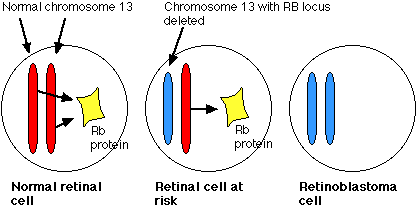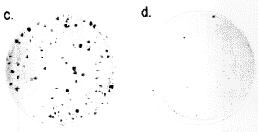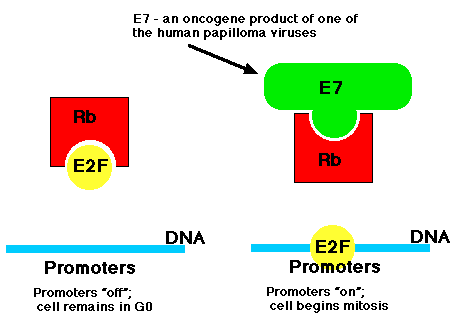Familial retinoblastoma occurs when the fetus inherits from one of its parents a chromosome (number 13) that has its RB locus deleted (or mutated). Then random mutation of the remaining RB locus in any retinal cell removes the inhibition provided by the Rb protein and the affected cell grows into a tumor. So, in this form of the disease, a germline mutation plus a somatic mutation of the second allele leads to the disease.

In this disease, both inherited Rb genes are normal and a single cell must be so unlucky as to suffer a somatic mutation (often a deletion) in both in order to develop into a tumor. Such a double hit is an exceedingly improbable event and so only rarely will such a tumor occur. (In both forms of the disease, the patient's life can be saved if the tumor(s) is detected soon enough and the affected eye(s) removed.)
The product of the tumor suppressor gene p53 is a protein of 53 kilodaltons (hence the name).
The p53 protein blocks cells from passing beyond G1 in the cell cycle. It does this by binding to a transcription factor called E2F. This prevents E2F from binding to the promoters of such proto-oncogenes as c-myc and c-fos. Transcription of c-myc and c-fos is needed for mitosis so blocking the transcription factor needed to turn on these genes prevents cell division.
(The Rb protein also prevents mitosis by blocking cells in G0.)
Genes like RB and p53 are also called anti-oncogenes. They were first given this name because they reverse, at least in cell culture, the action of known oncogenes.

This image (courtesy of Moshe Oren, from Cell 62:671, 1990) shows petri dishes which were seeded with the same number of cells that had been transformed by two oncogenes: myc and ras. Many of those on the left have grown into colonies of cells. However, the cells plated on the right also contained the tumor suppressor p53 gene. Only a few have been able to grow into colonies.
| Link to another illustration of the additive effect of myc and ras. |
The name anti-oncogene may be even more appropriate than originally thought. Both the Rb protein and the p53 protein turn out to complex directly in the cell with oncogene products.
Of the several human papilloma viruses (HPV) that infect humans, two have been implicated as a risk factor for cervical cancer. Once inside the cells of its host, one of these synthesize a protein, E7, which binds to the Rb protein preventing it from binding to the host transcription factor E2F.

Result: E2F is now free to bind to the promoters of genes that cause the cell to enter the cell cycle (right). Thus E7 is an oncogene product.
A second human papilloma virus implicated in cervical cancer also encodes an oncogene product, a protein called E6. E6 binds the p53 protein preventing it from keeping the host cell from entering the cell cycle.
| Welcome&Next Search |